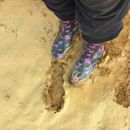Preparing footings in wet clay soil?
My contractor is pushing to install our concrete footings as soon as possible. I’m trying to make sure he’ll be creating a permanent stable foundation for my home.
My contractor recently installed culverts under my driveway totally wrong, and at least one is already partially crushed at just 2 weeks old. I had to look up the manufacturer’s installation instructions myself in order to discover he made seven different errors when putting them in – and now he’s going to have to take them both out.
So, right now I don’t really trust his work. Regarding my foundation, I need to know what to watch for, and who to ask professional advice about this situation, if needed.
Our soil was tested last year, and a soil engineer provided foundation details suitable for our moderate shrink/swell clay.
But we’ve had a LOT of rain over the last month. The footing trench hasn’t been dug yet. Parts of the crawl space excavation had been submerged under water for 7 straight days last week, while other parts were only submerged 2-3 days and have been above water since.
He pumped out most of the remaining water last Friday (see one photo before pumping), but much of the surface of the excavation is still extremely muddy as of today. (see second photo).
One person warned me that’s it’s really important for the soil at the bottom of the entire footing trench to be evenly moist; otherwise, as the wetter soil dries, it could shrink significantly more than the drier soil, and my foundation could settle unevenly.
But we have’t gotten any long enough periods of clear weather in weeks to dry the soil out properly. I’m also concerned he’ll try taking his backhoe into this muddy crawl space to dig the footing trenches before it dries enough.
How can I best make sure that this process is handled properly? It’s one thing to make him replace culverts done wrong – but a whole different thing for an entire foundation! Thanks.
GBA Detail Library
A collection of one thousand construction details organized by climate and house part











Replies
I don't know the particulars of your soil or foundation design so don't make any decisions based on my brief comments, but in general...
The engineer most likely designed your footings based on the load bearing capacity of undisturbed soil. Even if your footing trench had been excavated before the rain, it can take quite a while before sitting water can saturate undisturbed clay to the point where it changes its load bearing capacity. Which is one reason you usually want to pour the concrete as soon as possible after excavation.
It comes down to whether the soil no longer exhibits characteristics of "undisturbed" soil and is no longer cohesive. I recommend you ask your engineer to review the site and make a proper determination. This will probably cost extra, but is well worth the money in my opinion.
Note that in the worst case where the amount of water and time has effectively created "disturbed" soil, then the existing footing design may no longer be valid - even if the soil dries out.
Assuming the soil is still "undisturbed", standing water in the trench when you pour the concrete does not matter - as long as ALL of the water that the concrete wants to displace has a way to exit the immediate area. If all of the water has somewhere to go, then the concrete will displace it and it won't change the characteristics of the concrete.
Debra,
I agree with T.
Hire an engineer to make a site visit and provide recommendations.
Thank you! Sounds like good advice. The crawl space excavation was dug just 2 days before the remnants of Hurricane Florence came through and dumped 4 to 5 inches of rain on us.